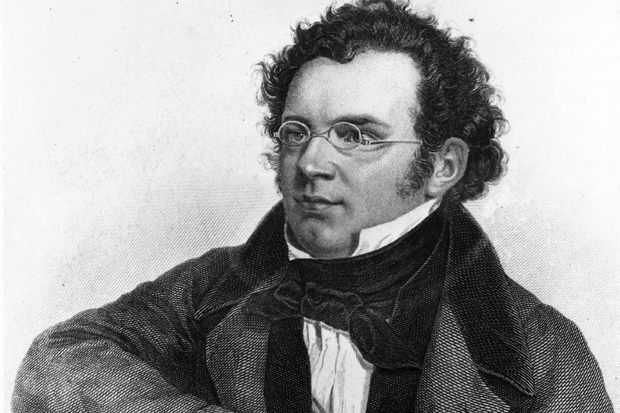You can tell a lot about a book from its bibliography. It’s the non-fiction equivalent of skipping to the final page of a novel. Turn to the end of Ian Bostridge’s Schubert’s Winter Journey — a study of the composer’s celebrated song cycle Winterreise — and you’ll find monographs on ornithology, weeping as a cultural phenomenon and wood sculpture in Renaissance Germany, essays on Samuel Beckett and the history of the mail coach, and the rather forbidding ‘Regulation of floral organ abscission in Arabidopsis thaliana’. Intrigued? Who wouldn’t be?
As academic disciplines go, musicology was a slow starter. It took until 1985 for Joseph Kerman to startle academics into looking beyond the musical score, to start systematically forging connections with art, philosophy, literary and gender theory. Things have changed a lot since then, and a book like this — written, Bostridge himself stresses, by an author never formally trained in music — shows just how much, and how much for the better.
Bostridge is a performer, a classical tenor whose relationship with Winterreise extends over 30 years and more than 100 performances. He’s also an academic, a former historian whose PhD on witchcraft became his first published book. It’s a curious vantage point, one that combines ferocious curiosity and intelligence with a lived, practical experience of music. Bostridge brings the knowledge of an expert but none of their jargon to this unexpected book that treats each song in this inscrutable cycle as an object in a cabinet of curiosities — to be handled and enjoyed as well as theorised.
If Wagner’s Ring cycle, Mahler’s Third Symphony and Berlioz’s Les Troyens are the megaliths of classical music, then Schubert’s Winterreise is a miniature. Seventy minutes of music are scored for just voice and piano and divided into 24 songs, loosely connected by a narrative that follows a rejected lover’s wanderings in a wintry landscape. If that seems like a fragile basis for a 500-page study, it won’t by the time Bostridge has made his case.
Working chronologically through the cycle, Bostridge gives each song its own chapter. It’s an approach that privileges the episodic experience of hearing (or performing) the cycle over its complete dramatic arc, but one that’s a truthful reflection of the sometimes rather arbitrary narrative and song-sequence of the original. Taken in isolation, each song becomes a prism for the social, political and musical milieu of Schubert and the 1820s. ‘Auf dem Flusse’ (‘On the Stream’), for example, becomes a jumping-off point for discussing geology and the Romantic obsession with winter, ‘Erstarrung’ (‘Frozen Stiff’) for exploring sexuality in Biedermeier Vienna and the mythology of Schubert-the-homosexual, while ‘Der Wegweiser’ (‘The Signpost’) ponders syphilis and the novels of James Fenimore Cooper.
Bostridge covers a lot of ground, at speed, but the artlessness of his prose (conversational, without ever feeling contrived) carries the reader along with inquisitive, interrogative force. Rather than an account of discoveries made earlier, there’s the sense that the book itself is an act and process of discovery, crystallising the thoughts, instinctive responses and research of decades into text. It wanders, like Schubert’s hero, drifting and alighting in unexpected places. These are essays true to the exploratory spirit of Montaigne’s original Essais — their etymological origin crucially in ‘essayer’ (‘to try’). There’s an appealingly democratic approach to knowledge that places the history of Napoleon and Metternich on equal footing with concert-hall anecdotes and analysis of the genius of Bob Dylan. When Bostridge describes Winterreise as ‘the first and greatest of concept-albums’ it’s not a gimmick, just a wide-lens approach to cultural history that places Schubert, Dylan and Amy Winehouse in a single arc of singer-songwriters.
Dominated by its visual associations — stiff-backed sofas upholstered with primly striped silks, ringleted silhouettes hanging on the walls — the term ‘Biedermeier’ conjures a certain cosiness, an aesthetic domesticity. One of Bostridge’s chief achievements here is to reclaim the movement’s revolutionary underpinnings, its origins in the oppressive rule of Metternich. Far from a solipsistic, sentimental hero of the salon, Schubert’s wanderer becomes a figure of protest — an anticipation of the alienated narrators of 20th-century art.
Though it roams far, Schubert’s Winter Journey never loses sight of the music that is its source. To finish the book is to come full circle; just as Schubert’s narrator finds himself beginning his songs all over again, to the sinister accompaniment of the hurdy-gurdy man, so the reader finds himself drawn back to CD and concert hall to attempt this elusive and allusive winter journey one more time.






Comments